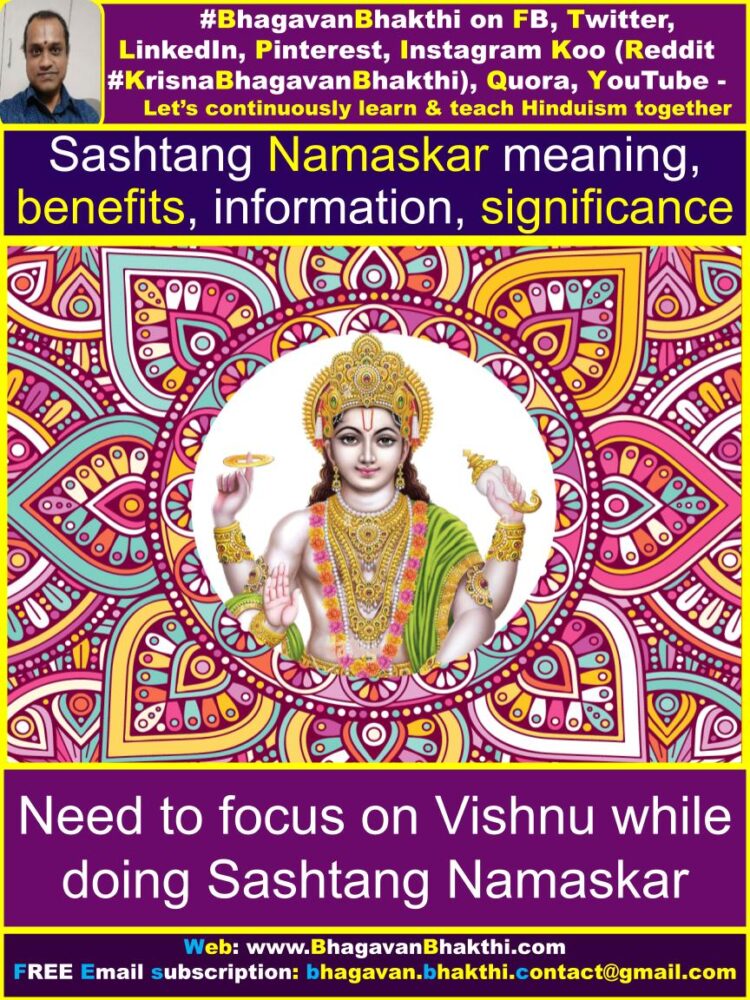Sashtang (Sashtanga) Namaskar meaning, benefits, information, significance | Can ladies do sashtanga namaskaram? | What is the benefit of Sashtanga (Yoga) asana?
Namaste friends, how are you doing today? Welcome to #BhagavanBhakthi website / blog.
Bhagavan Lord Sri Vishnu (Krishna) (Rama) (Hari) (Narayana) (Trivikrama) (Narasimha) (Vedavyasa) and Goddess Lakshmi (Rukmini) (Sita) (Dharini) blessings to you and your family!
In this website / blog, you will always learn about #Hinduism #Sanskrit language.
Also subscribe to my YouTube channel from this link #BhagavanBhakthi to view videos about #Hinduism #Sanskrit language.
Just before going to “Sashtang (Sashtanga) Namaskar meaning, benefits, information, significance | Can ladies do sashtanga namaskaram? | What is the benefit of Sashtanga (Yoga) asana?“, let us have some brief information.

Sashtanga is pronounced in different ways like Sashtang Namaskar, साष्टांग नमस्कार, sāṣṭāṅga namaskāra, Sashtang Namaskara, Sashtang Namaskaram, etc.
Sashtanga namaskaram is the best way of doing namaskaram or namaste or namaskara to Bhagavan (God), Devatas (Demigods), Rishis (Sages), Elders etc. This involves both physical and mental abilities. Let us know about this now.
First of all, let us know the correct meaning of the word ‘saashtaanga or sāṣṭāṅga’:
Saashtanga = sa + ashta + anga. Here, Sa means along with all, ashta means eight, anga means body parts. Total meaning of this is, ‘doing namaste or namaskar using all our 8 body parts’.
Now let us know the correct meaning of ‘namaskara or namaskar’: namaskara = nama + as + kaara (kara). Here nama = doing pranam / salutations / obeisances, as = me, kaara = doing. Total meaning of this is, ‘I am doing namah (namaste) to Bhagavan (God) or Guru (Teacher) or Elderly people etc.
Thus, Sashtanga Namaskara means, ‘I am doing namah (namaste) (namaskara) (namaskar) (namaskaram) to Bhagavan (God) / Guru (Teacher) / Elderly people etc. using all my eight body parts’.
Those eight body parts are: 1. Two toes | 2. Two knees | 3. Two palms | 4. The chest | 5. The forehead.

This means, touching the ground as a mark of bhakti / devotion, respect, salutations, obeisance and total surrender to the Bhagavan (Lord) Sri Vishnu, other Devatas (Demigods) Guru, Elderly people etc.
It is the best sampradaya / traditions of Sanatana Dharma and Samskriti percolated down from elders that we follow even today in our daily lives while offering salutations, respect etc to Bhagavan Sri Maha Vishnu, other Devatas, Guru, elders etc.
Sashtanga Namaskar is also one of the type of ‘yoga asana’ and forms a part of Surya Namaskaram.
Can ladies do sashtanga namaskaram? – Women (ladies) are restricted from performing ‘Sashtanga namaskara’ as their vaksha sthala / chest part, abdomen and waist should not touch the ground. In women’s case it will be a ‘panchanga namaskara’ (five body parts namaskara’).

‘Sashtanga Namaskara’ should be performed with utmost bhakti / devotion, humility and not as a routine drill and without bhakti / devotion. It is a way of realizing ourselves and the God who is present inside us as ‘antaryami’ (divinely present inside us). It removes ego and pride within us.
Let us understand from a shloka on how a ‘sashtaanga namaskara’ should be made:
उरसा शिरसा दृष्ट्या मनसा वचसा तथा । पादाभ्यां कराभ्यां जानुभ्यां प्रणामोष्टाङ्गा ईरितः॥
ಉರಸಾ ಶಿರಸಾ ದೃಷ್ಟ್ಯಾ ಮನಸಾ ವಚಸಾ ತಥಾ । ಪಾದಾಭ್ಯಾಂ ಕರಾಭ್ಯಾಂ ಜಾನುಭ್ಯಾಂ ಪ್ರಣಾಮೋಷ್ಟಾಂಗ ಈರಿತಃ ।।
urasā śirasā dr̥ṣṭyā manasā vacasā tathā। pādābhyāṁ karābhyāṁ jānubhyāṁ praṇāmōṣṭāṅga īritaḥ।।
In the above given shloka from Sri Krishnamruta Maharnava (written by Sri Madhvacharya Ji) it describes how a proper ‘sashtanga namaskara’ is to be performed in front of Bhagavan Sri Vishnu, other Devatas, Guru, Elders etc.
Meaning of the above shloka: Here it should be note that while performing the ‘sashtanga namaskara’, five body parts, that is, chest, head, feet, two hands and two knees touching the ground and our three sense organs, that is, mind, eyes and tongue (speech) are all focused on the Bhagavan Lord Sri Vishnu.

Let’s consider another sloka from Hindu Texts which gives more information about Sashtanga Namakaram as given below:
रेणुकुंठितगात्रस्य कणा यावंती भारत | तावद्वरष सहस्राणि विष्णुलोके महीयते ||
ರೇಣುಕುಂಠಿತಗಾತ್ರಸ್ಯ ಕಣಾ ಯಾವಂತಿ ಭಾರತ । ತಾವದ್ವರ್ಷ ಸಹಸ್ರಾಣಿ ವಿಷ್ಣುಲೋಕೇ ಮಹೀಯತೇ ।।
rēṇukuṇṭhitagātrasya kaṇā yāvanti bhārata। tāvadvarṣa sahasrāṇi viṣṇulōkē mahīyatē।।
In ‘Sri Krishnamruta Maharnava’ Sri Madhvacharya Ji says that:
Meaning of the above shloka: “when we do ‘sashtanga namaskara’ in front of Bhagavan (for example in temples), our body touches the dust of the floor of the feet of ‘Lord Sri Vishnu or other Gods Bhaktas / devotees’ who have worshiped Bhagavan (God) in that temple.
And thus one will live for so many thousands of years in ‘Vishnulokas or higher planets’ (as per our earlier Karmas) equivalent to the amount of dust particles that our body is blessed with”.

Sanatana Dharma is amazing right! The shastra / scripture / text, that is, ‘Sri Krishnamruta Maharnava’ further says in shloka #93:
शाठ्येनापि नमस्कारं कुर्वतः शारग्नापाणए | शतजन्मार्जितं पापं नश्यत्येव न संशयः ||
ಶಾಠ್ಯೇನಾಪಿ ನಮಸ್ಕಾರಂ ಕುರ್ವತಃ ಶಾರ್ಜ್ಗಾಪಾಣಯೇ । ಶತಜನ್ಮಾರ್ಜಿತಂ ಪಾಪಂ ನಶ್ಯತ್ಯೇವ ನ ಸಂಶಯಃ ।।
śāṭhyēnāpi namaskāraṁ kurvataḥ śārjgāpāṇayē। śatajanmārjitaṁ pāpaṁ naśyatyēva na sanśayaḥ।।
The meaning of this shloka is: Even though if one salutes (does namaskar) Bhagavan Lord Sri Vishnu or other Gods, that is, (He is the holder of the ‘Sharnga’ bow – dhanur-dhaari) out of pride and ego, the sins accumulated in hundred births will be eliminated, it will happen definitely and there is no doubt about it.

When such is the case of the merits and uses of doing ‘sashtanga namaskara’, one should definitely try to understand the greatness and significance of the great ‘sashtaanga namaskara’.
And one should do Sashtanga Namaskaram with utmost bhakti / devotion, humility in a namaskara position / meditative mood with focus on Bhagavan Lord Sri Vishnu, other Devatas, Gurus, elders etc. and not just as a routine.
One should that, ‘saashtaanga namaskaara’ should be done on regular basis (everyday), to get more and right fruits out of it.
But, we should also note that, one should do with bhakthi / devotion and without expectation from Bhagavan (God). We should do it in ‘nishkaama’ (without any expectations) and with ‘kaama’ (expectations).
It is a symbol of total sharanaagati / surrender at the lotus feet of Bhagavan Lord Sri Vishnu and other Gods. By doing ‘saashtaanga namaskaara’, we can also destroy our ego and pride very easily. But this cannot be accomplished easily. It requires a long time bhakti / devotion towards Bhagavan Lord Sri Vishnu and other Gods.

Why Don’t women do the ‘sashtanga namaskaara’? – Women should do the ‘panchanga namaskara’ (five body parts namaskara). Women shouldn’t do the ‘sashtanga namaskara’ as woman’s body parts like chest, abdomen will touch the ground.
Since as per the ‘Sanatana Dharma’ shastra (Hindu Texts), a woman’s chest and abdomen shouldn’t touch the earth. This is because, woman feeds her baby with her milk and safeguards the baby in her womb for 9 months.

Note : Different occasions call for different namaskaras. Here are some guidelines. For example “Rolling Namaskar” (Urulu Seva) (usually practiced in South India) is not at all recommended especially for women. A woman’s chest should not touch the ground while doing namaskaram.
Thus “sashtanga namaskar” is also forbidden for women. If in doubt, simple namaskaram can be done. Just bow down and do namaskaram with highest devotion or kneel and bow with Panchanga Namaskara.

Benefits of doing Sashtanga Namaskaram or Sashtanga (Yoga) Asana are as given below:
1. You become mentally and physically strong. 2. Blood flows from your head up to toe systematically and as per requirement. 3. You will lose your ego and pride.
4. Sashtanga namaskaram improves the flexibility of the spine and strengthens the muscles of the legs and arms. It also increases flexibility in the legs and shoulders.

How to do Sashtanga Namaskar or Sashtanga (Yoga) Asana:
1. Make your body in a plank position and slowly kneel down with your knees touching the floor.
2. Then slowly stretch your both hands forward where your both the palms should be touching the ground.
3. Later, only your chest must touch the ground (not your hip part and tummy).
4. Slowly, bend down your forehead (while doing namaskar) or chin (while doing yoga asana) and touch the floor slowly.


5. Stretch your both hands on the ground and keep it in the namaste position (or keep both of your hands side-by-side near your chest).
6. After this, slowly get back on your knees and sit in that position for 5 – 10 seconds.
7. Finally sit in the normal Padmasana or simple sitting position.
8. During all these steps you should remember Lord Sri Vishnu, his different avatars, should also remember the pastimes of Lord Sri Vishnu’s different avatars.

Continue reading about Hindu Samskaras (Sanskars) – Hindu Samskaras (Sanskar) information, significance, importance.
More information will be added to this on regular basis, please visit after some time to know more information.
To watch videos on #Hinduism #Sanskrit language, SUBSCRIBE to my YouTube channel from this below link:
#BhagavanBhakthi YouTube channel
Dear friends, if you need any clarifications about this post, kindly let me know, I will definitely try to answer all of them.
Also your one LIKE, one COMMENT, One Share, one SUBSCRIPTION is highly important.
This will help to know the quality of this content and also it will be helpful to know if any improvements is required for the content.
If you feel this content is useful to you and has helped you to improve your knowledge, kindly share this with your well-wishers.
Because “SHARING MEANS CARING”.
To receive FREE EMAIL SUBSCRIPTION about #BhagavanBhakthi, you can send an email to [email protected] from your email ID.
NAMASTE!
Sri Gurubhyo Namaha
Sri Krishnaaya Namaha
Sri Krishnaarpanamastu
Share in Social Media